"Stuff is eaten by dogs, broken by family and friends, sanded down by the wind, frozen by the mountains, lost by the prairie, burnt off by the sun, washed away by the rain. So you are left with dogs, family, friends, sun, rain, wind, prairie and mountains. What more do you want?" Federico Calboli
Friday, December 30, 2005
The Alligator at Machado Lake
The attempts to catch this critter have been an amusing comedy of errors and I regret now not having turned it into a running series here. First the City of Los Angeles hired a team of "gator wranglers" from Colorado (I know, so many alligators live there!) who thrashed around for two weeks, apparently spending more time trying to put a movie deal together than catch the gator. They failed, left town saying they would be back in a couple of weeks, and never returned.
In September, a ex-police officer admitted that the alligator was his pet that he had released into the lake, and that the animal's name was Reggie. So at least now we knew what to call him. Shortly after this, a second alligator appeared in Lake Machado. This fellow was only 2-3 feet long and promptly dubbed Little Reggie. It didn't take long for a group of firemen to catch Little Reggie in a net and his fifteen minutes of fame were over.
In October, the City hired a second team of gator wranglers from Florida. You would think these folks had a better chance of knowing their business. They also flailed around accomplishing little for a couple of weeks.
In the meantime, of course, Hurricane Katrina had hit, and a number of Louisiana evacuees came to Los Angeles in her wake. City Councilwoman (publicity hound) Janice Hahn showed up at lakeside, TV cameras in tow, with a Louisiana evacuee gentlemen who claimed to be an expert at gator trapping. She said that this would be a great opportunity to help an unfortunate unemployed displaced man find a job and wanted the City to use him. This fellow observed the Florida wranglers efforts and promptly pronounced their methods "retarded." The Florida people had their feelings hurt, left in a huff, and never came back. Apparently they had spent too much time talking to screen-writers and producers too.
The City tried to put the Louisiana man on the job, but there was a problem in that he didn't have liability insurance. After a little more checking, it turned out that he was a con-man, knew nothing about alligators, and there were several warrants out for his arrest. His fifteen minutes were over, too.
Since then, Reggie has been living large in the lake, dining pretty well on carp, ducks, and sea gulls. There hasn't been any more coverage of efforts to catch him, and as temperatures have cooled he is likely denned up somewhere in torpor.
But Janice Hahn can't let it go. She was in the middle of the press conference announcing the filing of charges against Reggie's owner and one of his friends. She admitted that the City has spent $155,000 trying to catch Reggie. She can't let go of Hollywood either - her latest brainstorm is negotiating with Steve Irwin, star of the Animal Planet cable channel show "The Crocodile Hunter," to launch another attempt soon.
I'll keep you posted.
Attack Chihuahuas
It's tough out there!
William W. Howells, RIP
Howells made significant contributions in breaking down what had been conventional wisdom about racial differences. He wrote numerous standard works in physical anthropology, some of which were in use when I first got started. He had a long and productive career.
Thursday, December 29, 2005
Seasons Change
One of the signs I have come to depend on that warm weather is over and cooler weather has arrived is when my gardenia bush stops blooming and my calla lillies grow back up and start. I went out in the early morning a couple of weeks ago to document my first calla of the season when I was surprised by something we rarely see here.
 Frost on the top of one of our cars. Shocking isn't it?
Frost on the top of one of our cars. Shocking isn't it?
 And here is that first calla, a much more reliable indicator of seasonal change than frost in my neighborhood.
And here is that first calla, a much more reliable indicator of seasonal change than frost in my neighborhood.
The Bible in Gullah
I have always found creole languages like Gullah and its counterparts in the British West Indies interesting with their African loan words and attempts to use the sentence word order of African languages with English words. The article gives some interesting examples.
My sole personal experience with a Creole English was on a trip to Jamaica, where the locals refer to it as "The Patois." It was absolutely incomprehensible to me.
Wednesday, December 28, 2005
Beale Street Bordellos
A number of other historic archaeology projects have uncovered remains of houses of ill-repute from the late 19th and early 20th centuries and there are even specialists who study what they call Late Victorian "sporting culture." The archaeologists find lots of liquor bottles, drug paraphernalia (especially syringes and opium pipes), and remains of medicine bottles and medical devices used to treat venereal diseases in those pre-antibiotic days. The first of these sites that I remember hearing about was the Vanoli Block excavated by Steven Baker in Ouray, a mining town in western Colorado.
Today Beale Street has been cleaned up and gentrified as an entertainment district, with nice restaurants and night clubs. BB King owns a nightclub there. Reading the article, one is given the impression that after prohibition was enforced in 1915, that Beale Street's days as a red-light district were largely over. Nothing could be further from the truth: it was a going concern well into the 1970s. Beginning in WWII, there has been a large military presence in Memphis from the Millington Naval Air Station north of town, and lots of sailors and marines ended up on Beale Street on the weekends. It was known as a dangerous part of town and most of us stayed away. A high school classmate of mine was murdered by a pimp there.
I was also interested by the article's references to the political power of E.H. Crump, who was the boss of a political machine that ran Memphis politics from his first term as mayor in 1910 until his death in 1954. Crump's machine wasn't as well known as the Dailey machine in Chicago or the Pendergast machine in Kansas City (that produced Harry Truman) but it was every bit as effective. Boss Crump was unusual in the Jim Crow era in that he respected and courted the African American community and allowed them a certain amount of autonomy. In contrast to most of the South, where blacks were actively disinfranchised, they were enrolled and allowed to vote in Memphis. In return for Crump's support, black ward-heelers and church leaders turned out the vote for his candidates.
Memphis was already the largest city in Tennessee, and its electoral weight was increased by its black voters, whose counterparts were kept from voting in the rest of the state. Boss Crump was the major player in Tennessee politics in the first half of the 20th century.
Beale Street was the exception to Crump's agenda, which was to make Memphis a "clean" city. I was a baby when Crump died, but the inertia of the government bureaucracry he formed continued long after his death. Memphis was always proud of being ranked as one of the cleanest (physically!) cities in the country and lots of attention was paid to street-sweeping and similar activity. You rarely saw homeless people - the police quickly hustled them out of town. Prohibition was of course, repealed, but its legacy continued in a series of baroque liquor laws that prevented restaurants from serving alcohol and kept bars from serving anything but beer. That didn't get changed until the early 1970s. One of the yardsticks of the city's virtue often cited in the newspapers was that "Memphis had more churches than service stations." I don't know that anyone tracks that statistic anymore.
One of the best examples of this attitude was that Memphis had a board of censors from the 1920s til the 1950s that had to approve all movies. It's hard to believe that Hollywood fare from this era was too racy for the general public, but the Memphis censors banned a large number of movies. The chairman and public face of the censor board was Lloyd Binford, who received accolades from religious leaders and was a figure of ridicule for the general public. The practical consequence of this was people drove 10 minutes to West Memphis, Arkansas where a number of theaters opened up and could see any movie they wanted. William Faulkner (a frequent visitor to Memphis) gained a measure of revenge in his novel The Reivers. Part of the novel is set (appropriately enough!) in a Memphis bordello, and Faulkner named its proprietor "Mr. Binford" as an inside joke for Memphians.
Boss Crump's machine mostly died with him, but machine politics is far from dead in Memphis. The African American community learned its lessons well from Crump, and after throwing off the shackles of Jim Crow built their own machine. Beginning with the election of Harold Ford Sr. to the Tennessee Senate in 1970, the Ford family has dominated Memphis politics. Harold Sr. won a seat in Congress in 1974 that he "passed" to his son Harold Jr. in 1996. The Fords have used the family funeral home business to network within the community. Now there are a series of Ford "family seats" on the Memphis City Council, Shelby County Commission, and Tennessee House and Senate. These have been passed around Harold Jr's uncles and aunt: Edmund, Emmitt, James, John, Joseph and Ophelia. Harold Jr. is now making noises about running against Bill Frist for US Senate.
It hasn't all been easy for the Fords. Harold Sr. was indicted on bank fraud charges in 1987 and acquitted. Emmitt resigned from the Tennessee House after an insurance fraud conviction in 1981. This year John resigned his seat in the Tennessee Senate after indictments on bribery, extortion and witness intimidation. Ophelia was forced to run in a special election in September to protect John's seat and won by 13 votes out of 8750 cast. But the more things change, the more they stay the same: turns out several of the votes in that 13 vote landslide were cast by dead people.
Long Term View of Climate
Tuesday, December 27, 2005
Norman Vaughn, RIP
Santa Rosa Island and Channel Islands National Park
 This year marks the 25th anniversary of the formation of Channel Islands National Park and the Los Angeles and Santa Barbara news media are carrying a number of pieces on issues related to the Park's history and management. This is a fairly thoughtful article on Santa Rosa Island (see above map). The most discussed and controversial issues on all the islands relate to control and/or eradication of non-native species that are crowding out threatened and endangered natives. Black rats have been eradicated from Anacapa Island, we have posted here previously on the eradication of feral pigs on Santa Cruz Island, and deer and elk are slated to be eradicated from Santa Rosa by 2011, when the last private in-holding there shifts to Federal control.
This year marks the 25th anniversary of the formation of Channel Islands National Park and the Los Angeles and Santa Barbara news media are carrying a number of pieces on issues related to the Park's history and management. This is a fairly thoughtful article on Santa Rosa Island (see above map). The most discussed and controversial issues on all the islands relate to control and/or eradication of non-native species that are crowding out threatened and endangered natives. Black rats have been eradicated from Anacapa Island, we have posted here previously on the eradication of feral pigs on Santa Cruz Island, and deer and elk are slated to be eradicated from Santa Rosa by 2011, when the last private in-holding there shifts to Federal control.The Channel Islands have been called the American Galapagos and they are a true national treasure. They are also covered with well-preserved Chumash archaeological sites and the oldest burial known from North America (13,500 BP) was found at Arlington Springs on Santa Rosa. Santa Rosa is also home to most finds of the pygmy mammoth.
No Love for Wolves

This LA Times piece carries a paradoxical message: the reintroduction of the wolf into areas of Idaho, Wyoming, and Oregon has a been a raging success biologically, but this has come in the face of unremitting hostility from locals (see above bumper sticker). The wolf has been one of the success stories of the Endangered Species Act - but as this article points out, Federal officials are afraid to de-list the wolf for fear of what state and local governments would then do to exterminate them.
The predation numbers carried in this article make it sound as though the Federal and state officials are talking past each other with emotion taking on science. That is becoming an old story here in the western states that have large areas of Federally-owned land. Local officials have an instinctive resentment of any Federal assertions of power in land management. But that's probably the subject of another post.
UPDATE
Please take a look at this. The LA Times has printed a correction. The press release from the governor of Wyoming saying that the ESA was not in force in his state quoted in the story has been revealed as an April Fool's joke swallowed by the reporter.
Friday, December 23, 2005
Steve's Return
Thursday, December 22, 2005
Another Set of Prehistoric Footprints
UPDATE
 That didn't take long. You can see some pictures here.
That didn't take long. You can see some pictures here.
Tuesday, December 20, 2005
Mommie Deepest
The New Madrid Earthquakes and Archaeology
We all think of California as the place for earthquakes, but this area in the lower Midwest has had worse in the past. This map from the USGS locates historic quakes and defines the New Madrid Seismic Zone.
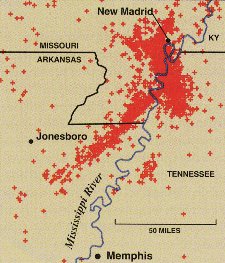 I was reminded of this when I read this article in Archaeology magazine (sorry but it's the abstract, not the full article) that tells how Missouri archaeologists are cooperating with geologists to use evidence of earthquakes in archaeological stratigraphy to date prehistoric earthquakes. I really liked this picture from the article showing one of the "sand volcanoes" cutting through an archaeological profile and scanned it for you.
I was reminded of this when I read this article in Archaeology magazine (sorry but it's the abstract, not the full article) that tells how Missouri archaeologists are cooperating with geologists to use evidence of earthquakes in archaeological stratigraphy to date prehistoric earthquakes. I really liked this picture from the article showing one of the "sand volcanoes" cutting through an archaeological profile and scanned it for you.
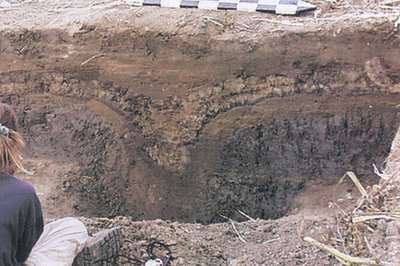 These methods have helped geologists to write a seismic history of the area, showing that the New Madrid Fault has had major earthquake events about every 500 years. People living there now aren't particularly well-prepared if the next one comes soon.
These methods have helped geologists to write a seismic history of the area, showing that the New Madrid Fault has had major earthquake events about every 500 years. People living there now aren't particularly well-prepared if the next one comes soon.
Kangaroo: It's What's for Dinner
Somehow I don't think the aborigines will care.
Monday, December 19, 2005
Frozen Mammoth Genetic Studies
The release treats these as mutually exclusive positions, but not enough information is provided to tell if this is strictly true - very frustrating! I guess we will see when the articles come out and we can compare them.
But it is very good news that we have good genetic material retrievable from frozen mammoths and that scientists are making good use of it.
Historic Wall in New York City
I'll just note in passing that the archaeologist mentioned as having examined the wall, Joe Schuldenrein, is a old colleague who is one of the best geoarchaeologists in the cultural resources business.
"On The Road" Manuscript Displayed
I have always enjoyed "On the Road" though my favorite of Kerouac's is "The Dharma Bums."
Mysterious Hot Spots
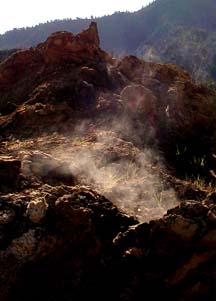 This picture comes from a piece in the Santa Barbara News-Press about some mysterious heat sources revealed by a landslide in the mountains northeast of here. I apologise, this may be a subscribers-only link.
This picture comes from a piece in the Santa Barbara News-Press about some mysterious heat sources revealed by a landslide in the mountains northeast of here. I apologise, this may be a subscribers-only link. This hit the news here early in the summer when a small forest fire that was caused by these "hot spots" led to their discovery. A team of geologists has recently revisted the location in a Wilderness Area in the Los Padres National Forest. Four vents have been measured at a temperature between 400 and 500 degrees F. For some reason, the geologists seem very reticent to call this a standard geothermal location, though they see steam, smell sulphur, and say they can hear water boiling down in the vents. One geologist has "... hypothesized that a chemical reaction in the shale is creating the heat, fueled by oxygen in the air and in the water seeping through the rocks. He notes that the slide is hottest on the side where the wind blows through, stoking a kind of blast furnace."
They are also keeping the location a secret, frustrating a lot of us who would like to run out and see it!
Steve's Whereabouts
Friday, December 16, 2005
War in the Middle East
It would be impossible to deny that the specter of aggression has been with us always. Constant Battles: Why We Fight, a book by archaeologist Steven LeBlanc shows that many of the earliest human fossils we have show evidence of violence. He demonstrates that the archaeological record all over the world is replete with examples. It is so pervasive, it seems woven into us.
In a comment to a post here a few days ago I said, "More than we want to admit, physically and mentally we are still curious and manipulative Pleistocene apes and it shows in all we do and say." I think I should amend that to "...curious, manipulative, and aggressive Pleistocene apes..."
Thursday, December 15, 2005
A Real and Present Danger
"For the first time in B.C. history, an anti-hunting group has bought the
guide-outfitting rights to a prime piece of the province's wilderness with a
view to ending permanently the commercial killing of all animals in the
area."
The numerical and financial clout of the combined anti-hunting movement is often cited. Its ability to trump hunters' groups in advertising and voting campaigns is well demonstrated. But this story illustrates the most frightening potential of those who would see hunting abolished: They may simply buy us out.
But the situation described in this piece seems complicated by the involvement (willing) of native tribes living in the region. Could it be that a strange-bedfellows agreement is in progress? The main target seems to be commercial trophy hunting, largely by foreigners. Native hunting may continue...
"According to provincial regulations, licensed guide-outfitters must continue to facilitate some hunting in areas for which they are responsible. Raincoast conservation director Ian McAllister, who helped broker the deal, said Raincoast
will live up to those obligations by allowing hunting of some ungulates -- hoofed grazing animals -- for food. But henceforth commercial trophy hunting will be a thing of the past."
Then to deal with the local competition?
"First nations representatives, who are negotiating a land and resource
management plan with Victoria, say they hope the deal will be expanded in early
2006 to include a ban on resident sport hunting as well. About 40 per cent of
all animals killed along the coast are killed by resident hunters. 'First
nations don't hunt for trophies,' said Heiltsuk chief Ross Wilson. 'We kill for
need, not desire.'"
Hunting without desire? Weird. Does the chief know his reasoning leaves the tribe vulnerable to the argument that if hunting for food---for "need"---is merely a necessary evil, wouldn't it be better for all parties to bag your groceries at Wal-Mart? Any while your at it, you ought to move into Vancouver apartment complexes (central heat and air!) and leave the wilderness to the animals.
Or at least to another breed of guide service. A second complication to the story appears as native inhabitants and former hunting guides seek the development of eco-tourism and a new source of revenue from abroad. Whatever the outcome here, however many the motives, the precedent of an anti-hunting group finally meeting its agenda by buying the resource outright...that should scare everyone.
Art and Science, Part 1.5
From the text by Toby Sterling: "...the researchers scanned a reproduction of Leonardo da Vinci's masterpiece and subjected it to cutting-edge 'emotion recognition' software, developed in collaboration with the University of Illinois. The result showed the painting's famous subject was 83 percent happy, 9 percent disgusted, 6 percent fearful and 2 percent angry. She was less than 1 percent neutral, and not at all surprised."
Neither am I.
More Wind Energy Follies
Some More Very Old Rock Art
One of the first questions I asked our tour guides at Little Petroglyph Canyon was if they knew where any petroglyphs like this might be. I was directed to this one.
 The petroglyph below the rectilinear figure and above the green lichen is thought by many to look like a mammoth. I think it has possibilities but is sort of an ambiguous figure. The main problem I had with it was that it didn't look any more patinated that any of the other figures around it - though again this is a subjective judgement.
The petroglyph below the rectilinear figure and above the green lichen is thought by many to look like a mammoth. I think it has possibilities but is sort of an ambiguous figure. The main problem I had with it was that it didn't look any more patinated that any of the other figures around it - though again this is a subjective judgement.
Clambering around the canyon alone, I did find this interesting petroglyph myself up near the north end.
 This may be a little difficult for you to see, partly because it did look very heavily patinated, therefore perhaps older, than the other petroglyphs around it. I have a cropped version here, that may make it easier to see.
This may be a little difficult for you to see, partly because it did look very heavily patinated, therefore perhaps older, than the other petroglyphs around it. I have a cropped version here, that may make it easier to see.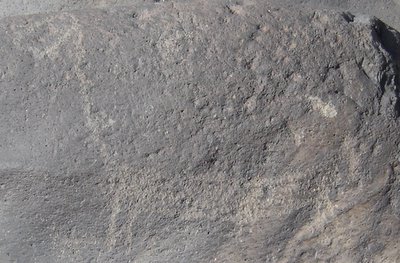 I see an animal with an oval head in the upper left-hand corner of the frame, that has a long neck shown as a single line, connecting to a rectilinear body. The body has a flat back, four proportionally short legs, and a short, bobbed tail. I have asked a number of folks for their opinions, but I think this could represent some sort of camelid, likely a llama.
I see an animal with an oval head in the upper left-hand corner of the frame, that has a long neck shown as a single line, connecting to a rectilinear body. The body has a flat back, four proportionally short legs, and a short, bobbed tail. I have asked a number of folks for their opinions, but I think this could represent some sort of camelid, likely a llama.
 How does it look to you? I think the neck is too long and the legs and tail too short to be a horse. I think the back is too flat and the legs too short to be a camel.
How does it look to you? I think the neck is too long and the legs and tail too short to be a horse. I think the back is too flat and the legs too short to be a camel.
Llamas were common here in California during the Pleistocene (as were camels), with two species, the stout-legged llama (Paleolama mirifica) and the large-headed llama (Hemiauchenia macrocephala) present in the Rancholabrean fauna. Both became extinct about 10,000 years ago - making this petroglyph at least that old if it represents one.
I sent this picture to a couple of people knowledgeable of Coso rock-art to check if they had seen it and what their opinion was but have not gotten a reply yet. A hundred feet or so down the canyon I saw this petroglyph.
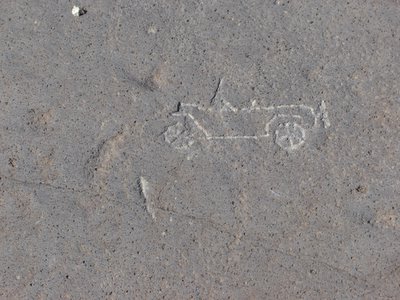 It is one of very few (I saw two others) historic pieces of graffiti in the area. Of course, some may think this representation of Model-T culture is very old.
It is one of very few (I saw two others) historic pieces of graffiti in the area. Of course, some may think this representation of Model-T culture is very old.
Wednesday, December 14, 2005
Earliest Known Mayan Painting
 Whatever it may say about Pre-Classic Mayan culture - namely that these people were more sophisticated at an earlier time than previously thought - this 2,100 year old painting from Guatemala is a dazzling work of art.
Whatever it may say about Pre-Classic Mayan culture - namely that these people were more sophisticated at an earlier time than previously thought - this 2,100 year old painting from Guatemala is a dazzling work of art.This leads me to reflect on how art is so intrinsically woven into us as a species. We really seem to be driven to it. The earliest art that we have from European caves shows a high degree of skill and imagination - reinforcing my old dictum that our early, "primitive", H. sapiens ancestors were just as intelligent as we are.
Paleoindian Skulls from South America
Much was made of the characterization of Kennewick Man's (9,300 BP) features as "Caucasoid" a few years ago, so I'm sure that this will cause a stir as well. The Brazilians believe that this indicates a wave of migration from Asia earlier than that of the Mongolian types that are the ancestors of modern American Indians.
I will have to take a look at the journal article when it comes out next week to comment intelligently, but this appears to be another in a wave of discoveries relating to the peopling of the Americas that show it was a very complicated series of events. Right now there is more new data coming out than can be fit in our theoretical frameworks. It is an exciting time but a confusing one. Charles Mann's new book 1491 has a chapter on the peopling of the Americas that gives a decent run-down of many of the competing theories, but it also shows the disarray that all this unassimilated new data has caused.
Tuesday, December 13, 2005
California Tsunami Preparedness
We do have them here, historically. This article talks about 80 in the last 150 years. Here in Santa Barbara County, a local account of an earthquake and tsunami in 1812 is said to have pushed a ship a half-mile up Refugio Creek and then back out to sea.
After the Indian Ocean tsunami, I took a look at the topographic maps of this area that I have on the wall in my office, and decided if a big one hits here during working hours I may be toast. Our office building is just about a mile from the beach, elevation 5 ft., on the north edge of Goleta Slough, a large creek and wetland that is mostly filled in and used as the airport. The mouth of Goleta Slough is flanked by two bluffs 40-50 ft. high and a tsunami hitting there would be funneled by the bluffs, pushed higher and therefore farther inland and aimed right at us. There wouldn't be time or opportunity to go inland. About our only chance would be to go to the second floor or roof of our two-storey building and hope that it was high enough and the building strong enough to hold out.
If one hit on the evening or weekend and we were at home we would probably be okay. Our house is in the foothills, two miles from shore, at a lofty 120 ft. Highway 101 is in a cut between the shore and our house, and that "trench" would absorb lots of the force.
Not nervous or anything, just thinking ahead.
The Real Unicorn
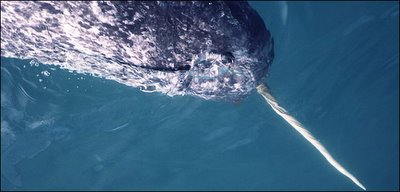 I heard a fascinating interview on the radio on the way into work this morning describing the narwhal research project detailed in this NY Times piece, whence the picture comes.
I heard a fascinating interview on the radio on the way into work this morning describing the narwhal research project detailed in this NY Times piece, whence the picture comes.We have known about narwhals and their tusks - passed off as "unicorn horns" in earlier times - for many years. But we have only speculated about the tusk's function (spearing fish?, breaking ice?, digging the seabed for food?) until this study.
Turns out the tusk is really a sensory organ, a nine-foot probe covered in nerve endings that allow the animal to detect subtle changes of temperature, pressure, and particle gradients in its environment. Pretty cool!
It occurs to me that the fact it took this long to answer such a basic question about this animal's anatomy may say more about the difficult logistics of fieldwork in the Arctic as anything.
Hunting Good for Wildlife? Imagine!
As a patriotic, horn-tooting falconer, I immediately assumed "Peregrine recovery," although that story is a little crusty, even for we hacks. Turns out this one is about the Ivory-billed Woodpecker, a bird arguably saved from annihilation by hunters' annual purchase of duck stamps and the government protection of wild lands this revenue allows.
Sometimes we forget, or maybe refuse to accept, that without one or both of the following there would be no "wild land" left: human interest in it, and money. Arkansas, God bless her, holds a lot of duck hunters.
Monday, December 12, 2005
Just a Sunset
Yosemite Lawsuit Thrown Out of Court
Sunday, December 11, 2005
A Visit To New Orleans
On a tip from Steve's friend Andrea (now working as an insurance estimator), I met with the pastor of a Baptist church in the Ninth Ward area. That neighborhood, as we know from news reports, suffered some of the worst flooding. I drove around a bit, carefully between huge piles of debris and the clearing crews, not quite recognizing places I've seen for twenty years. I took my photos, some of building interiors obviously untouched since the waters receded---no footprints in the dried mud. Stuff still on top of stuff.
In Arabi, St. Bernard Parish, where my friends Tom and Jennifer once lived, the destruction was worse. Buildings I knew as landmarks were no longer there. I got lost. I had to ask directions to streets I've found many times in the dark and a little bit drunk. But there in Arabi, a distinctive neighborhood (as each is in New Orleans), I found a little humor, too. "Arabians" are known for poking fun at themselves---their idioms ("Where y'at, dawlin? How's yer mom an'dem?") and their blue collar roots. Some are still at it. I take that as a good sign.


"Like New..." Maybe true!

Weird effects (they were everywhere, even three months later):
A neighbor's water heater suspended on a fence.
Saturday, December 10, 2005
The Nash-Reid-Hill House
 While back in Jonesboro, AR a few weeks ago I stopped by the old family home to take some pictures. I had always liked the house and had been there many times while growing up to visit my great aunt Ruth who lived there.
While back in Jonesboro, AR a few weeks ago I stopped by the old family home to take some pictures. I had always liked the house and had been there many times while growing up to visit my great aunt Ruth who lived there.
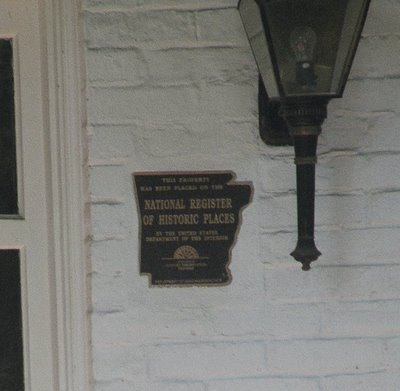 It was a big thrill for me when I saw this plaque by the front door and learned that my cousin Clifford Toney, who inherited the house, had had it nominated for the National Register and that it had been accepted. It is on the Register as the Nash-Reid-Hill House. The nomination says that it was significant for "its association with the Nash family, prominent in the pharmaceutical business as far back as 1875, and who played an important role in the field of medicine in pre-World War II Jonesboro." It is also significant as an exemplar of the Queen Anne style of architecture.
It was a big thrill for me when I saw this plaque by the front door and learned that my cousin Clifford Toney, who inherited the house, had had it nominated for the National Register and that it had been accepted. It is on the Register as the Nash-Reid-Hill House. The nomination says that it was significant for "its association with the Nash family, prominent in the pharmaceutical business as far back as 1875, and who played an important role in the field of medicine in pre-World War II Jonesboro." It is also significant as an exemplar of the Queen Anne style of architecture.
My great-great grandfather Travis Nash (1852-1919) made a good deal of money manufacturing patent medicines. Prominent among them was Nash's Chill Tonic, a nasty-tasting quinine-based potion that my father remembers being dosed with in the 1930s. The chill tonic is a reminder that malaria and yellow fever were fairly recently still endemic in many parts of the country - a fact that seems to have fallen into the memory hole. Travis Nash built the house in 1898.
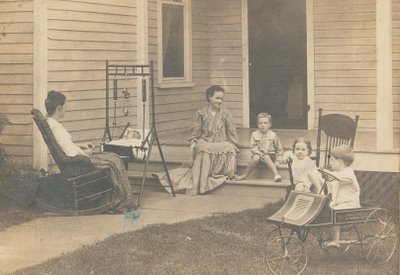 This picture was taken out back of it in 1905. The woman sitting on the porch is my great-grandmother Flora Nash Reid (1878-1940), Travis' daughter. She was recently widowed, as her husband Augustus Reid (1876-1904) had died of tuberculosis the previous year. She never re-married and inherited the house when her father died. She was a pharmacist, and owned and managed Reid's Drug Store that she had established with her husband until her death.
This picture was taken out back of it in 1905. The woman sitting on the porch is my great-grandmother Flora Nash Reid (1878-1940), Travis' daughter. She was recently widowed, as her husband Augustus Reid (1876-1904) had died of tuberculosis the previous year. She never re-married and inherited the house when her father died. She was a pharmacist, and owned and managed Reid's Drug Store that she had established with her husband until her death.
The little boy on the porch next to her is her son, my grandfather, Travis Reid (1900-1979). He has a bandage on his left foot and I wonder what sort of accident he had. The little girl is his sister, my great aunt Ruth Reid (Hill) (1902-1991). The other woman, baby, and little boy (love that kiddie car!) are friends from the Ellis family.
When Flora died, my grandfather inherited the drug store and Aunt Ruth got the house. Her grandson, my cousin Clifford, recently sold it and it is being well-maintained by the new owners.
If a Sparrow Should Fall
The sparrow's execution sparked controversy among the Dutch: Was it justified? Was it legal?
Evidently not.
Even though House sparrows (Passer domesticus) are still common in the Netherlands, according to the article the specie was placed last year on that country's endangered list. The listing comes in recognition of a 50% decline in its abundance in recent decades. A similar finding, not mentioned in Sterling's piece, is the House sparrow's marked decline in the British Isles, ironic since the bird's most familiar name here is the "English sparrow."
So the carcass of the sparrow was seized by Dutch authorities and the exterminator fined by public prosecutors at The Hague. The stuffed (or pickled, they haven't decided) sparrow will now be placed in a museum, perched for eternity on a box of dominoes.
Whether this story is funny or not might be debated. But it hits some of Querencia's favorite topics (animals, government, weird hobbies, to name a few) and I submit it for your consideration.
But this line I found genuinely amusing. Note the reason given for the decline of the domestic sparrow(!): "Although common, the house sparrow's numbers have fallen by more than 50 percent in the past 20 years due to human encroachment on their habitat."
There has to be another reason...
Friday, December 09, 2005
Kaplan, Kipling and Things That Don't Change
I was a little disappointed in the book, as it appeared curiously uneven. I enjoyed the Mongolia and Fallouja pieces when they appeared in the Atlantic so much that my expectations were maybe too high. I wasn't prepared for the savaging he got however, when David Lipsky reviewed his book in the NY Times.
Lipsky has some valid criticisms of how Kaplan has stumbled. Kaplan's dual roles as travel writer and foreign affairs analyst are sometimes at war with each other and the book suffers for that. Kaplan tries for fine literary effects and occasionally falls short using trite adjectives and mixed metaphors.
After a bit though, Lipsky leaves the book and takes after Kaplan personally. He says Kaplan, "... over his career, appears to have become someone who is too fond of war." Kaplan favorably contrasts the intelligence, capability and patriotism of American soldiers to that of cosmopolitan elites and Lipsky then insinuates he's a hypocrite for having a cosmopolitan lifestyle: he has lived overseas for extended periods and has a Canadian wife. I think that really means that Kaplan has direct experience with both and is calling them the way he sees them. Frankly, Kaplan has worked his way up the hard way, his success was a long time coming. If you read his books you know he doesn't parachute into a country, he walks the streets and that is one of his strengths. Lipsky sounds jealous.
Finally we get this from Lipsky: "Despite this, Kaplan, the realist, has elsewhere defined his realism as "an unrelenting record of uncomfortable truths. . . . The realism exhibited here may appear radical." In fact, it tends toward the cozily familiar: like evolutionary psychology, his findings don't so much upset conventional wisdom as support it with a surprising pillar. Most situations, however novel, will submit to cold-war realpolitik and the "he's-our-son-of-a-bitch" alliance."
Steve and I kicked this around a bit and his take was: "Pretty good critique of the book- though I still like most of it. But of Kaplan? Maybe evolutionary psychology and realpolitik (like Kipling) strike us as true because they ARE. Do you know his poem The Gods of the Copybook Headings?"
I had not read that Kipling poem, one of Steve's favorites, and here it is for you.
The Gods of the Copybook Headings
AS I PASS through my incarnations in every age and race,
I make my proper prostrations to the Gods of the Market Place.
Peering through reverent fingers I watch them flourish and fall,
And the Gods of the Copybook Headings, I notice, outlast them all.
We were living in trees when they met us. They showed us each in turn
That Water would certainly wet us, as Fire would certainly burn:
But we found them lacking in Uplift, Vision and Breadth of Mind,
So we left them to teach the Gorillas while we followed the March of Mankind.
We moved as the Spirit listed. They never altered their pace,
Being neither cloud nor wind-borne like the Gods of the Market Place,
But they always caught up with our progress, and presently word would come
That a tribe had been wiped off its icefield, or the lights had gone out in Rome.
With the Hopes that our World is built on they were utterly out of touch,
They denied that the Moon was Stilton; they denied she was even Dutch;
They denied that Wishes were Horses; they denied that a Pig had Wings;
So we worshipped the Gods of the Market Who promised these beautiful things.
When the Cambrian measures were forming, They promised perpetual peace.
They swore, if we gave them our weapons, that the wars of the tribes would cease.
But when we disarmed They sold us and delivered us bound to our foe,
And the Gods of the Copybook Headings said: "Stick to the Devil you know."
On the first Feminian Sandstones we were promised the Fuller Life
(Which started by loving our neighbour and ended by loving his wife)
Till our women had no more children and the men lost reason and faith,
And the Gods of the Copybook Headings said: "The Wages of Sin is Death."
In the Carboniferous Epoch we were promised abundance for all,
By robbing selected Peter to pay for collective Paul;
But, though we had plenty of money, there was nothing our money could buy,
And the Gods of the Copybook Headings said: "If you don't work you die."
Then the Gods of the Market tumbled, and their smooth-tongued wizards withdrew
And the hearts of the meanest were humbled and began to believe it was true
That All is not Gold that Glitters, and Two and Two make Four
And the Gods of the Copybook Headings limped up to explain it once more.
As it will be in the future, it was at the birth of Man
There are only four things certain since Social Progress began.
That the Dog returns to his Vomit and the Sow returns to her Mire,
And the burnt Fool's bandaged finger goes wabbling back to the Fire;
And that after this is accomplished, and the brave new world begins
When all men are paid for existing and no man must pay for his sins,
As surely as Water will wet us, as surely as Fire will burn,
The Gods of the Copybook Headings with terror and slaughter return.
Poles Will Wander
This interesting phenomenon is a boon for archaeologists and geologists due to a principle called remnant magnetism. When magnetic iron-bearing minerals crystallize or when they settle slowly out of a liquid medium, individual mineral grains align themselves with the existing magnetic field of the earth. Over long periods of time, when new minerals are deposited, the alignment changes as the pole moves. By measuring polarity, variations in intensities, and changes in inclinations through a sequence of sediments or rocks, researchers can reconstruct paleomagnetic history.
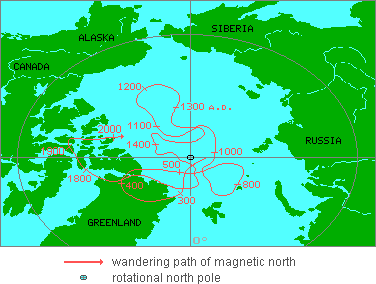 This shows how the north magnetic pole has moved over the last couple of thousand years. This reconstruction is a benefit to archaeologists, as heating soils to high temperatures causes their mineral grains to change their remnant magnetism to the pole alignment at the time of the heating. Through a technique called archaeomagnetic dating the inclination of mineral grains in clays from ancient firepits or kilns, can be compared with the known "track" of the pole and a date derived. This technique is not used as much as radiocarbon as it is an exacting process to gather the soil samples - a specialist has to come visit your site to do it. It is much easier to take carbon samples and mail them in to a lab. But it is a good fall-back technique.
This shows how the north magnetic pole has moved over the last couple of thousand years. This reconstruction is a benefit to archaeologists, as heating soils to high temperatures causes their mineral grains to change their remnant magnetism to the pole alignment at the time of the heating. Through a technique called archaeomagnetic dating the inclination of mineral grains in clays from ancient firepits or kilns, can be compared with the known "track" of the pole and a date derived. This technique is not used as much as radiocarbon as it is an exacting process to gather the soil samples - a specialist has to come visit your site to do it. It is much easier to take carbon samples and mail them in to a lab. But it is a good fall-back technique.
Geologists use paleomagnetic studies for dating purposes, but also have used the techniques to map continental drift. One aspect of paleomagnetism that has fascinated me since I took Geology 112 at Tulane, is that numerous times in the past the poles have done more than just wander - they have reversed positions entirely. A compass needle would have pointed north at some times and south at others. Geophysicists have been able to document more than 400 polarity reversals over the last 330 million years.  This graph shows the polarity reversals over the last 4 million years. Average interval between reversals is about 700,000 years, though the standard deviation is high. Looking at this chart you can see the last one was about 800,000 years ago - so we're due.
This graph shows the polarity reversals over the last 4 million years. Average interval between reversals is about 700,000 years, though the standard deviation is high. Looking at this chart you can see the last one was about 800,000 years ago - so we're due.
What would a polarity reversal due to our civilization? Compasses would be the least of our worries - what would the effect be on generators or electric motors for example? Supposedly the reversal events occur over periods of hundreds or even several thousand years, but it's hard to imagine what a transitional period would be like. We conceive of polarity as a binary phenomenon. Maybe a geophysicist out there can explain it to us.
I've thought for many years that a polarity reversal should join an asteroid strike on our planetary worry list. What do you think?
Thursday, December 08, 2005
Hottest Year "On Record"
 I borrowed this chart from the LA Times a few weeks ago and it is a good illustration. Frankly, I think all that this really tells anyone is that in 1878, Los Angeles was a small town with no paved roads and in 2005 it is a paved-over megalopolis with lots of concrete and asphalt that holds heat.
I borrowed this chart from the LA Times a few weeks ago and it is a good illustration. Frankly, I think all that this really tells anyone is that in 1878, Los Angeles was a small town with no paved roads and in 2005 it is a paved-over megalopolis with lots of concrete and asphalt that holds heat.
Climate cycles are multiple centuries long. We know this because of indirectly observed temperatures based on what is called proxy data. Hundreds of climatologists all over the world gather data from tree-rings, ice cores (oxygen isotope ratios), pollen from soil cores, microfossils from deep sea cores, etc. that tell them what temperatures were over ranges of hundreds of thousands of years. This book tells you all about those techniques. They give you useful, long-range charts like this one.

This chart shows a range of temperatures for the last 400,000 years above and below the average for the last 100 years based on proxy data from an ice core in Antarctica. The spikes indicating higher temperatures show the interglacial periods like the one we are in now. The lower readings indicate the cool glacial periods. Looking at this chart shows that to be entirely accurate, 2005 can't be the "hottest year on record", in fact there are probably hundreds of years in the last three interglacials that were hotter than 2005.
It irritates me that climate scientists like the one who gave the "hottest year" press release I linked to above, know this perfectly well. It gives me the impression that they aren't being entirely honest.
Genetic Map of Dogs Completed
An interesting aspect of this piece is how intertwined dogs and humans have become over the last 14,000 years, and the almost unique emotional bonds that we are able to form cross-species. If you remember, we talked about that some here a few days ago.
Wednesday, December 07, 2005
A New View of Easter Island Prehistory
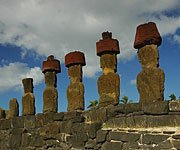 The deforestation led to erosion and the decline of agriculture, the carrying capacity of the island was surpassed and it all ended in a cannibalistic civil war with resultant population collapse about AD 1650. This story has been most recently been told popularly in Jared Diamond's best-selling book Collapse.
The deforestation led to erosion and the decline of agriculture, the carrying capacity of the island was surpassed and it all ended in a cannibalistic civil war with resultant population collapse about AD 1650. This story has been most recently been told popularly in Jared Diamond's best-selling book Collapse.
But an archaeologist from the University of Hawaii has just presented a paper that challenges all of this. He believes the culprit for deforestation was a human-induced species of rat that did the work prior to substantial human settlement. The radiocarbon dates and pollen data seem to hang together with this scenario. Additionally, he really can't find much of any evidence of warfare in the archaeological record. If I remember my long-ago readings of Thor Heyerdahl correctly, the war and cannibalism was based on an Easter Island native folk-tale.
This ought to be another of those archaeological controversies that will be fun to watch.
Wind Energy Noise Problems
Complaints about noisy wind turbines have caused San Bernardino County to reconfigure their entire permitting process for residential turbines. This is for the small units that individuals can buy and put in their yards, which if they are noisy are particularly obnoxious for neighbors. As someone who lives next to one of them said, "It sounds like having a B-17 on the runway warming up for takeoff."
Tulane Revives
This piece in the LA Times describes Tulane's reopening for the Spring semester. That is great to see and I admire some of the creative planning that it took. For example, as public schools are not going to reopen in that area for some time, Tulane has taken over a school building near campus and will operate it for the children of the faculty. Also, Tulane is taking in faculty and students from Xavier and Dillard Universities, which are located in areas of town that were heavily flood damaged. Hopefully, prospective students for Tulane won't be put off by its location in the storm-ravaged city, but will be stimulated to be part of the rebuilding process.
Tuesday, December 06, 2005
Big-Box Safari
One aspect this piece mentions that hadn't occured to me was that these stores can act as "propaganda" centers for encouraging new hunters and fishermen.
Sad News from Mongolia
Sunday, December 04, 2005
Russian Girls and Kalashnikovs
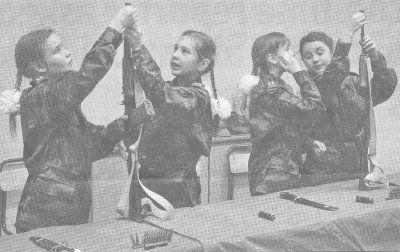 Steve likes most things Russian and admired this photo of girls cleaning their rifles that Roseann passed on to us. Also Roseann's comments: "I love their little hair pom-poms, and just their expressions, you can just hear the ones on the right, 'So, did you see Yuri last night at the dance? Wasn't he just soooooo cute?!' gossiping as they strip and reassemble Kalashnikovs."
Steve likes most things Russian and admired this photo of girls cleaning their rifles that Roseann passed on to us. Also Roseann's comments: "I love their little hair pom-poms, and just their expressions, you can just hear the ones on the right, 'So, did you see Yuri last night at the dance? Wasn't he just soooooo cute?!' gossiping as they strip and reassemble Kalashnikovs."
Friday, December 02, 2005
Re: Read The Whole Thing
The LA Times article that forms the basis for Matt's post prominently describes students balking at large reading assignments in "analog". I can remember classmates of mine balking like that as far back as Christian Brothers High School: "Gee, Brother Leander, do you really expect us to read all that?" That was long before the invention of the Web, but as one of my classmates said, "That's why God invented Cliffs Notes." We had teachers who would buy Cliffs Notes so that they could design tests with questions on material that the Cliffs Notes summary didn't cover. These were not popular teachers.
So maybe the way to look at the Web is as an enhanced version of Cliffs Notes, and the students who really want to read (a minority) will, and those who would prefer to get out of it (the majority) will try to find ways not to. I would say there are many in my generation that are as "aliterate" as the younger generation mentioned in the LA Times - though I don't know what the percentage comparison would be.
Now, Matt works at the LSU library, sees more of the interaction of students and books than I do, and probably has more insight as to whether this is a truly different phenomenon.
Speaking of the LSU library, I heard from a reliable source, that of the eight books there, four of them haven't even been colored in yet. Can you confirm that, Matt?
Now That Looks Like an Eruption
 Re: my post yesterday on the "quiet" eruption of Mount St. Helens. I borrowed this shot of Popocatepetl (I love those Nahuatl names - the glottal stops give me chills!) in Mexico from the front page of today's LA Times.
Re: my post yesterday on the "quiet" eruption of Mount St. Helens. I borrowed this shot of Popocatepetl (I love those Nahuatl names - the glottal stops give me chills!) in Mexico from the front page of today's LA Times.
Thursday, December 01, 2005
Principles
It occurs to me that my "Blogfamily" shares a vague yet real constellation of values.
In no particular order or hierarchy:
Conservation/ "Green" values, but not the PC kind-- we tend to be hunters or at least carnivores.
Love for traditions, old things, learning-- meritocracy?
"Social libertarianism"-- small "l".
Respect for / adherence to evolutionary paradigms.
But also respect for/ adherence to various religious beliefs.
Oh and-- strong women, self defense, love of dogs, and good food.
What say you all?
One More

A parting shot...

I'll trust Reid and Matt to keep you informed and amused. Please check in, refresh often, buy my books, and keep Libby entertained with comments. I'm just traveling--fleas, cold, at worst bandits. She has to work, to ride herd on the beasts, to organize car repairs and computer ditto, and to supervise the building of two buttresses so our east wall doesn't fall down!! Why she puts up with me I'll never know.
"Story"
But story gets no respect. Michael:
"Before the conversation rockets off in one predictable direction: I'm fond of a lot of fancy nonnarrative (and semi-narrative) fiction, theater, and movies. I was throughly marinated in modernism, I have a grad degree in this point of view, and I have many years' experience behind me as an appreciator of this kind of work. So puh-leeze: no lectures on my closed mind, or on my ignorance, or on how awful it is that I'm trying to be a dictator. Writers can (and will) do as they please. Of course, readers can (and will) read to please themselves too.
"At the same time, I am asserting two things:
"The ability to invent, construct, and tell a galvanizing, moving, suspenseful, or amusing story is much undervalued by the litchat class.[Emphasis mine-- SB] And
(Snip)
"The trimmings artists pile on top of the main fictional course might fascinate and delight. But these are still, for most people and in the long run, trimmings."
Read the whole thing; and by the way, Matt, I stole that phrase from Glenn Reynolds--can't take credit!
"Conservatives"--??
"The designs of the neocons are so appallingly far fetched because they are infected with the same Rousseauvian fantasy of the worst leftist excess. Strip away the layers of socialization they say, and you’ll find a human as gentle as a lamb and as pliable as clay, and no two so different of ability that one can’t be substituted for the other provided the environment is controlled for. Reality refutes this notion daily, at home and abroad. The defenders of this pernicious fantasy grow shriller and more emphatic the more evident reality becomes. Courage is needed more than ever.
What we need are some old fashioned liberals and not-so-neoconservatives, with their quaint patrician values of respect for the limits of good intentions. Not every well intended idea, regardless of how noble it sounds, has a basis in reality.
"Nearly every sensible person at this point recognizes the folly of Marxism. Now it's time to stop gloating over that failure and apply its lesson to ourselves. Because in the end it’s not really the ideology, but the human heart which leads us into disaster."
(Generally, by the way, I object to the "Neocon" label-- it means too many different things to too many people. But the point he makes stands, for me).
"One of the Most Popular Things Our Government Has Done"
Says Dog Politics: " We beg to differ. The majority do not support this ban. Every major animal welfare organization throughout Canada, the United States AND in the U.K. has vehemently opposed the Ontario ban".
Canada is an ailing country-- at least Eastern Canada is (see this for an example or two). Somehow I can't see my friends from the west going for laws like this....
Mount St. Helens is Erupting
 I certainly didn't know it until I read this piece in the New York Times a couple of days ago. It has been erupting quietly for the past 15 months. A column of hardened but still hot lava is being pushed up the main tube into the crater at the rate of a cubic yard per second. This has resulted in a dome that is building there.
I certainly didn't know it until I read this piece in the New York Times a couple of days ago. It has been erupting quietly for the past 15 months. A column of hardened but still hot lava is being pushed up the main tube into the crater at the rate of a cubic yard per second. This has resulted in a dome that is building there.I visited Mount St. Helens for the first time in July while returning from a trip to the Seattle area, and took the picture I posted above. If you look closely you can see the dome inside the crater and the steam coming off of it. While there, I didn't see anything that referred to the current eruption, though to be fair we weren't there long enough to go into the main visitor's center. During the violent eruption of this volcano in 1980, we lived in Boulder, CO and I vividly remember the ash fall from it on my car.
Though born a flatlander, I have lived in or around mountains (Rockies and Sierra Nevada) for half my life. Seeing Mount St. Helens was unique in that it was the first time I have ever had a strong emotional reaction to a mountain. It seemed brooding and monstrous to me.
Dec 1 Doom, Gloom, Derb, & China News
John also comments on this story of an environmental disaster, which they are handling the way they did SARS: incompetence followed by denial.
And then there is the bird flu panic. Scott Weidensaul, an excellent writer--see here for some of his books-- takes note of the hysteria here. He tells you who (NOT wild birds) is responsible. But guess who wants to cull the birds now?
Matt says, savagely: "If I'm for drilling ANWR, I'm all over this. Let's drain the "big swamp" of Arctic waterfowl breeding grounds and rid ourselves of disease-ridden birds and mosquitoes in one swoop. The world is clearly warming, which is a great thing and means millions of acres of under-developed real estate are about to open up. Let's get a jump on this and turn tundra
wasteland into productive farms and cities and oil refineries. It's only the patriotic thing to do, even
if we have to invade Canada to do it."
Getting Ready..
The plot: I have been asked by two women my own age (relevant-- one correspondent said the if we were all twenty- something hardbodies we would already have an article sold) to be the token male and "bodyguard"on an expedition to the mountains of southeast Turkey to find new tazi/ saluki pups-- new genetic material-- in an area where one of them, an anthropologist, got her foundation female twenty years ago. Both their local guide and their husbands wanted me to go!
Hardly a life- or - death mission, but it's still old PPK guerilla territory and has been closed off in the past. There have been bombs going off near Batman (great name for a town!) but we don't intend to go that far east (near Iraq). On the other hand, we do intend to go near Syria. We have been told not to travel at night (PPK bandits) and to be very polite to trigger- happy Turkish patrols.Yes sir.
And-- how to put this delicately?--I am NOT a spy ! A couple of years ago, my friend Richard Miniter--click here for his latest book--mentioned my Asian travels to Samizdata's Brian Micklethwait. Brian had a creative take on my birdwatching in faraway places:he thought I was a spook!
"People who habitually watch birds in countries other than their own are as likely as not spooks of some kind, in my opinion. After all, what better way is there to spy on metal birds and their habitats, and such like, than to pretend to be looking only at regular ones? And this bird man is also a gun man. Add the fact that one of Richard's forthcoming books is about Bill Clinton's (mis)handling of al-Qaeda and is apparently full of juicy revelations, and you get the picture. These guys may not have spook ranks and spook serial numbers, but they definitely have good friends who do."
Honestly--much as I admire Richard Meinertzhagen, I am just a writer. Turkish police with computers, take note.


